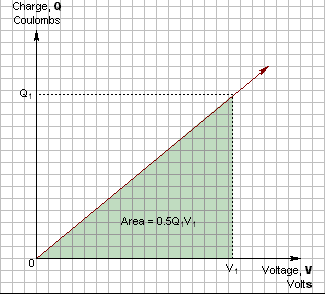<^< Charge Capacitance and Voltage | Course Index | Examples: Capacitance >^>

Graph of energy storage related to charge and voltageThe energy stored in a capacitor is the area under the graph of charge (Q) plotted against voltage (V). This area is given by:
Area = half height times base
= ½ Q V
Since Q = CV:
Area = ½ (CV) x V
Thus the energy stored in a capacitor is proportional to the product of the capacitance and the square of the potential difference, i.e.
E = ½ C V2
where E is the energy (in Joules), C is the capacitance (in Farads), and V is the potential difference (in Volts).
<^< Charge Capacitance and Voltage | Course index | Examples: Capacitance >^>
